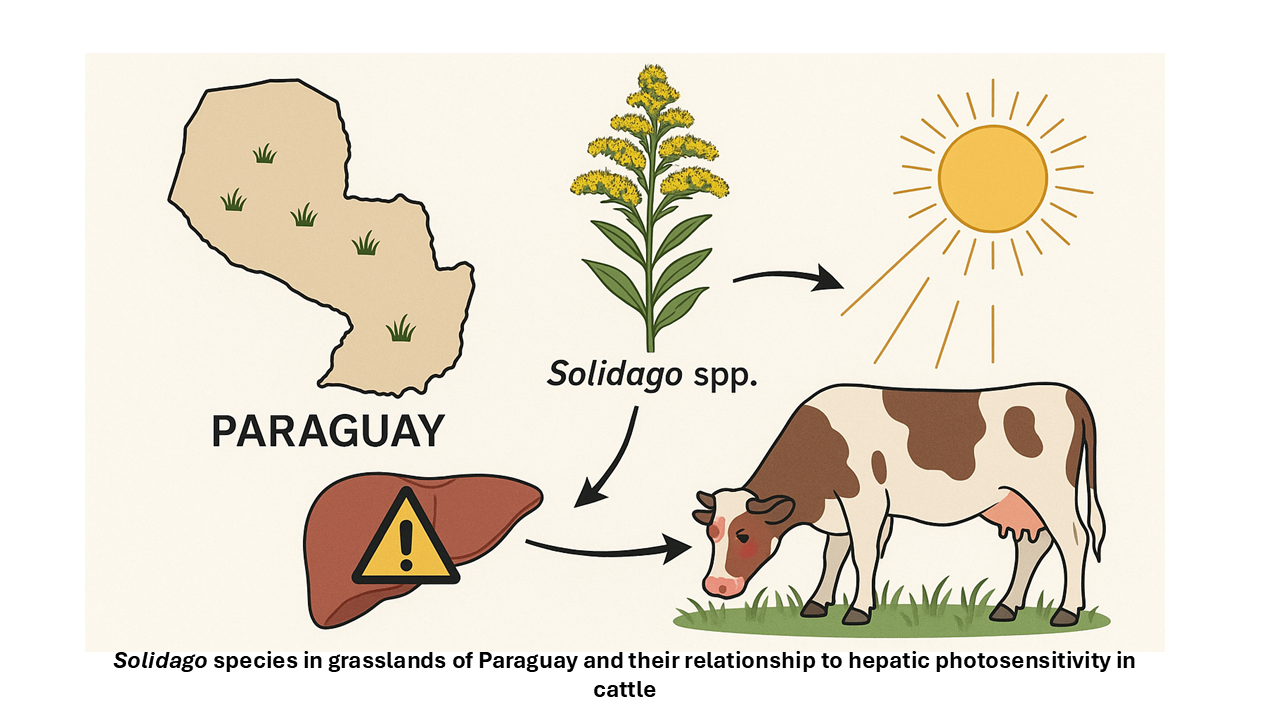Solidago species in grasslands of Paraguay and their relationship to hepatic photosensitivity in cattle
DOI:
https://doi.org/10.14295/bjs.v4i7.753Keywords:
Solidago spp., weeds, photosensitivity, cattleAbstract
Paraguayan livestock production uses forage grasses as a basic diet. Many species of weeds grow in these pastures, and some of them, like the Solidago genus, are toxic to the animals. This genus is reported to cause hepatic photosensitivity in cattle due to the toxic compound, saponins, contained mainly in the leaves. Saponins induce liver damage because they hamper the breakdown of photodynamic metabolites like phylloerythrin, formed from chlorophyll metabolism. Some species of Solidago are recognized in South America, but only two species are reported in Paraguay, and have been a cause of confusion in their identification and distribution due to the great morphological similarity they have. In the past, Solidago chilensis was the only species recorded in Paraguay and was related to causing hepatic photosensitivity in cattle. However, recent studies of the genus have demonstrated that Solidago microglossa is the dominant species of the genus Solidago in Paraguay, widely distributed across these grasslands. Therefore, the objective of this research is to define the dominant species of Solidago in Paraguay and as the primary cause behind photosensitive health disorders in cattle.
References
Ávila-Torres, I., D´Elia, G., Vogt, C., & Garcete, B. (2018). Análisis crítico de la biogeografía del Paraguay. Reportes científicos de la FACEN, 9(1), 42-50. https://doi.org/10.18004/rcfacen.2018.9.1.42 DOI: https://doi.org/10.18004/rcfacen.2018.9.1.42
Arambarri, A. M., & Hernández, M. (2014). Variación estacional de saponinas en Solidago chilensis var. chilensis (Asteraceae). Boletín de la Sociedad Argentina de Botánica, 49(4), 483-489. http://www.scielo.org.ar/scielo.php?script=sci_arttext&pid=S1851-23722014 000400006 DOI: https://doi.org/10.31055/1851.2372.v49.n4.9882
Paraguay. (2012). Asociación Rural del Paraguay (ARP). Introducción al Paraguay y su sector cárnico. Available at: http://www.arp.org.py/. Accessed 20 June 2024.
Baggio, A. L., Buskievicz, A., Fornari, A., Franke, T. A., & Lucca, P. S. (2012). Investigación fitoquímica de los principios activos presentes en el medicamento vegetal Solidago microglossa, DC. (Arnica brasileira). Thêma et Sciencia, 2(1), 149-153. http://www.themaetscientia. fag.edu.br/index.php/RTES/article/view/91
Bausaldo, I., Soria, N., Ortíz, M., Acosta, L., Degen, R., & Elizeche, A. (1992). Plantas tóxicas para el ganado en los Departamentos de Concepción y Amambay de Paraguay. San Lorenzo: Universidad Nacional de Asunción.
Chicourel, E. L., Pimenta, D. S., Jorge, L. I., & Ferro, V. (1998). Analytical knowledge of the medicinal Compositae. Revista Brasileira de Farmacologia, 7(1), 59-66. https://doi.org/10.1590/S0102- 695X1998000100007 DOI: https://doi.org/10.1590/S0102-695X1998000100007
DeEgea, J., Mereles, F., & Céspedes, G. (2018). Malezas comunes del Paraguay; Manual de Identificación. Available in: https://www.inbio.org.py/informes/publicaciones/Manual_Malezas-comunes-del- Paraguay.pdf. Accessed on: 15 March 2024.
Degen, R., González, Y., Britos, L., Delmás, G., González, G., Choi, S., & Kim, S. Y. (2016). Plantas colectadas en 5 departamentos de Paraguay y su estado de conservación. Rojasiana, 15(2), 67-85. https://www.qui.una.py/v2/wp-content/uploads/5ROJASIANA-152-Diciembre-2016.pdf
Gastaldi, B., Catalán, C., Silva-Sofrás, F. M., & González, S. (2018). Solidago chilensis Meyen (Asteraceae), a medicinal plant from South America. A comprehensive review: ethnomedicinal uses, phytochemistry and bioactivity. Boletín Latinoamericano y del Caribe de Plantas Medicinales y Aromáticas, 17(1), 17-29. http://hdl.handle.net/11336/119950
Harasymowycz, J. B. (2015). Plantas tóxicas del Paraguay. Casos observados en bovinos. Asunción: Asociación Rural del Paraguay.
López, R. T., & Semple, J. (2015). A multivariate morphometric analysis of the Solidago chilensis group in South America and related taxa in North America (Asteraceae, Astereae). Annals of the Missouri Botanical Garden, 100(4), 423-441. http://dx.doi.org/10.3417/201402 DOI: https://doi.org/10.3417/2014023
Pedroso, R., Silva, C., & Fúrlan, C. M. (2009). Comparação dos principais constituintes químicos de duas espécies de arnica: cravorana (Porophyllum ruderale [Jacq.] cass) e varão-de-ouro (Solidago sp.). Revista Brasileira de Ciência da Saúde, 7(22). https://doi.org/10.13037/rbcs.vol7n22.515
Peralta, P. F., & Klich, M. G. (2021). Plantas tóxicas para el ganado en el valle medio de Río Negr: Guía de reconocimiento. Viedma: Universidad Nacional de Río Negro. Available in: ttps://editorial.unrn.edu.ar /media/data/enlaces/plantas_toxicas-2021_unrn.pdf. Accessed on: December 10, 2024.
Vogt, C. (2012). Composición de la flora vascular del Chaco Boreal, Paraguay II. Dicotyledoneae: Acanthaceae – Fabaceae. Steviana, 4, 65-116. https://doi.org/10.56152/ StevianaFacenV4A5_2012 DOI: https://doi.org/10.56152/ffs.v4i.1284
Zuloaga, F. O., Morrone, O. & Belgrano, M. (2008). Catálogo de las plantas vasculares del Cono Sur (Argentina, sur de Brasil, Chile, Paraguay y Uruguay). Monographs in Systematic Botany from the Missouri Botanical Garden. Available in: https://www.researchgate.net/publication/262688294_Catalogo _de_las_Plantas_Vasculares_del_Cono_Sur_Argentina_Sur_de_Brasil_Chile_Paraguay_y_Uruguay_volumen_2_Dicotyledoneae-_Acanthaceae-_Fabaceae. Accessed on: 15 March, 2024

Downloads
Published
How to Cite
Issue
Section
License
Copyright (c) 2025 Humberto Jorge Sarubbi Orue, Rosa Luisa Degen de Arrúa

This work is licensed under a Creative Commons Attribution 4.0 International License.
Authors who publish with this journal agree to the following terms:
1) Authors retain copyright and grant the journal right of first publication with the work simultaneously licensed under a Creative Commons Attribution License that allows others to share the work with an acknowledgement of the work's authorship and initial publication in this journal.
2) Authors are able to enter into separate, additional contractual arrangements for the non-exclusive distribution of the journal's published version of the work (e.g., post it to an institutional repository or publish it in a book), with an acknowledgement of its initial publication in this journal.
3) Authors are permitted and encouraged to post their work online (e.g., in institutional repositories or on their website) prior to and during the submission process, as it can lead to productive exchanges, as well as earlier and greater citation of published work.



